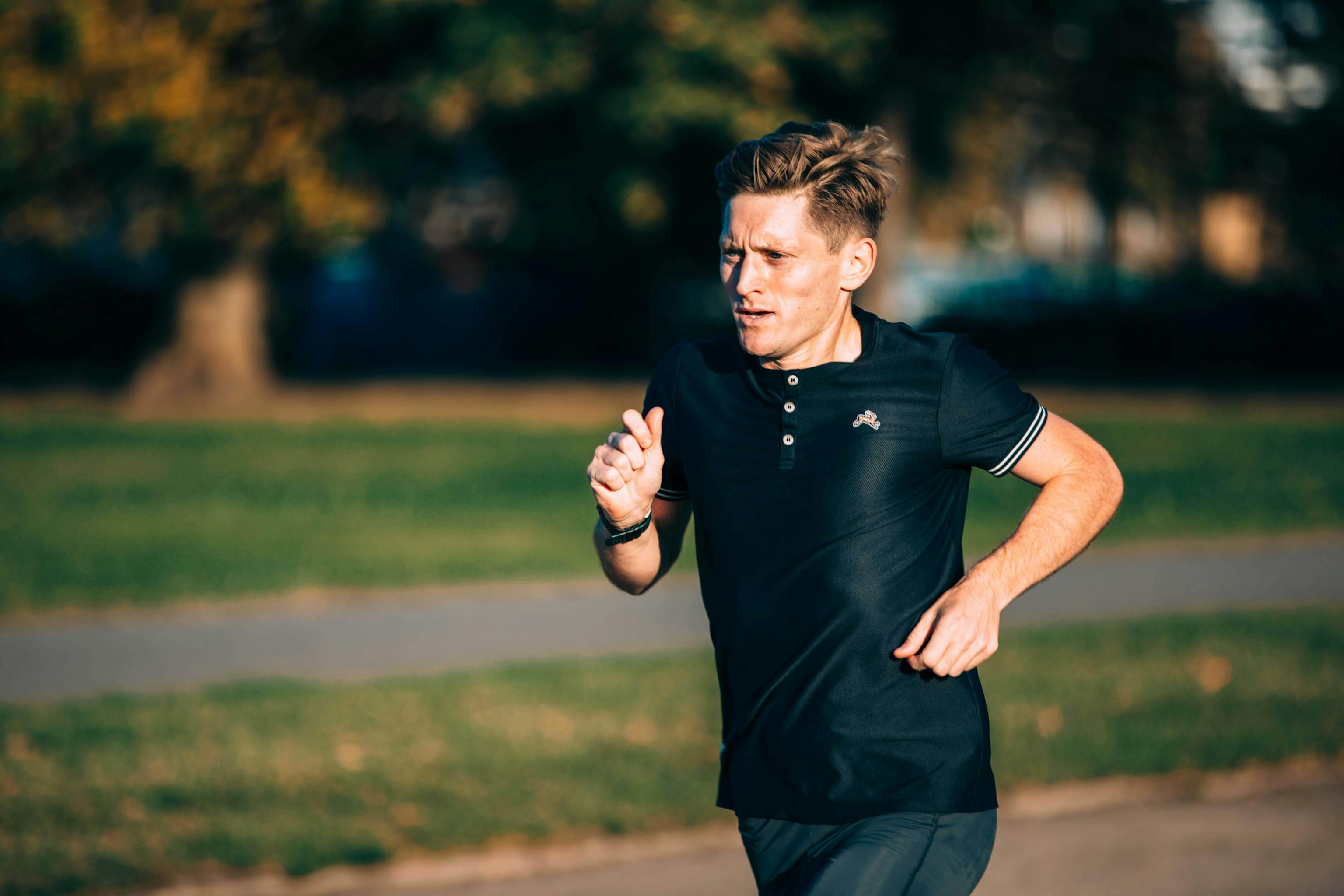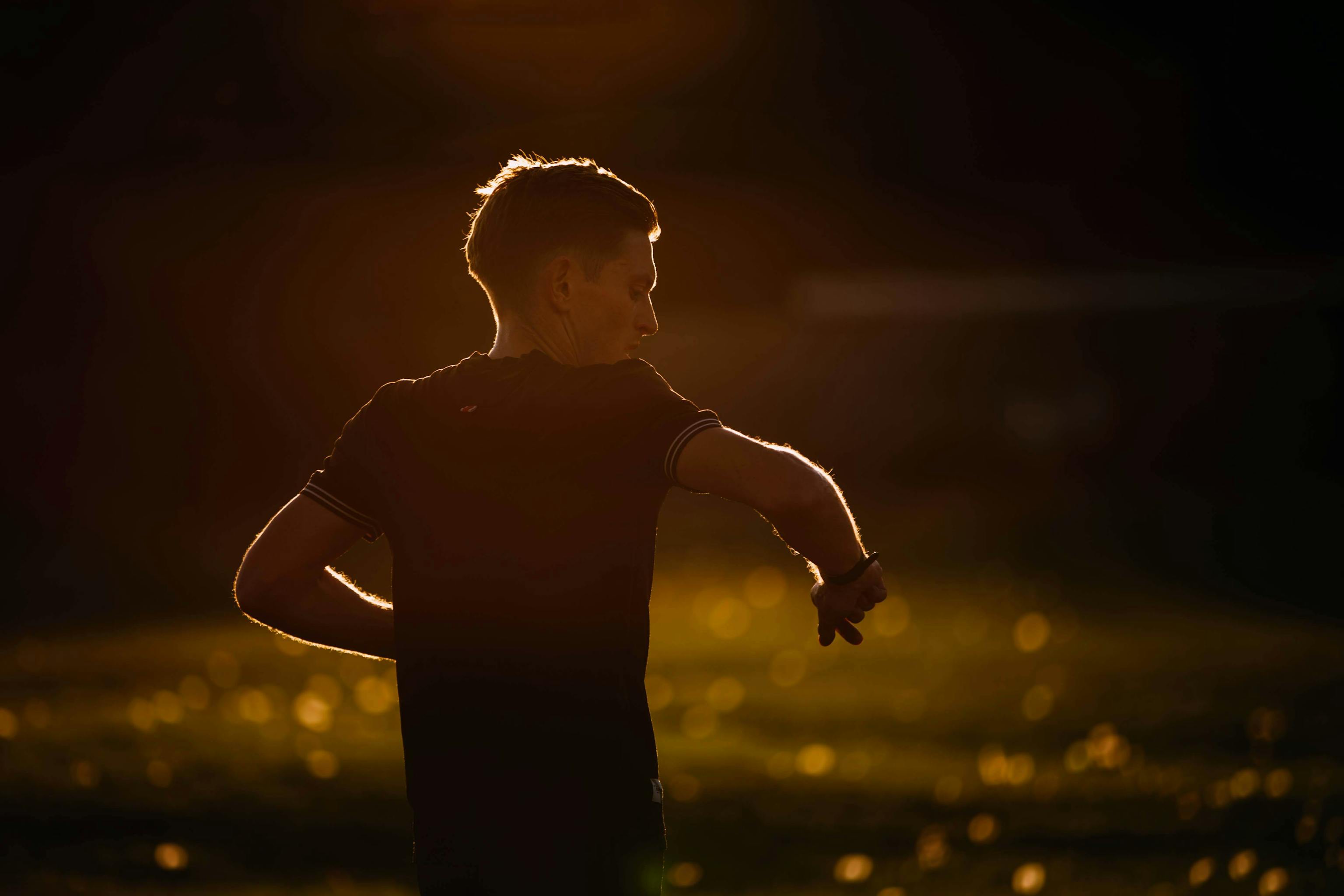
Footnotes
On running, fatherhood, and the immutable persistence of ambition
By Andy Waterman
Photography by Morgane Bigault
“Inside, we’re ageless. And when we talk to ourselves, it’s the same person we were talking to as when we were little, and it’s the body that’s changing around that ageless center.”
— David Lynch
OCTOBER 2018
Marathon - 18 days
Running isn’t about absolutes. It’s about laying markers in shifting sands1. Those markers never last for long: circumstances change, standards evolve, technologies progress. We grow up and we grow older. The only constant is ambition – and running without ambition is jogging2.
Somehow, I find myself stood on the precipice of middle age. Ambitions I’ve outpaced for the past quarter of a century3 have started to demand my attention. There’s an urgency tapping me on the shoulder, whispering, “if not now, when?”
I’m 38. My wife and I have one son and another on the way. My days of 25 mile long runs are numbered4. I need an outlet for the potential I was able to postpone through my 20s and early 30s.
If not now, when?
Marathons held no allure for me until the London Marathon of 2017. The sun was shining, and the city – my city – was showing itself in its best light.
I’m running and riding the tube from location to location to see friends, ending up by the Houses of Parliament at one mile to go. By the time the runners turn off the Embankment and skirt Parliament Square, very few people look good, or fast5. When three friends pass in quick succession, heading in to finish around 2:35, it makes me think... I wouldn’t compare myself to them in terms of talent, but certainly, in terms of dedication and circumstances we’re not so very far apart. And what is the marathon if not a test of dedication? If they can run that fast while working full-time jobs, maintaining relationships and being able to pass as normal adults, maybe I should jump into the carnival too?
To gain a Championship Time for London as a male, you need to have run under 2:45. There’s also the option to get in on a Good for Age time, but for some reason, ambition reasons that that is cheating. I either get in on merit, or I stay home. Over post-race drinks to celebrate his 2:33 clocking, Tracksmith’s Rafael Oliveira sows the seed of Valencia in the fall of 2017 – “it’s a fast course” he says, “and a great city. You could go fast there.”
I pay my entry fee before the glow of the lunchtime beer wears off.
Skip forward six months and I’m standing on a bridge in Valencia feeling supremely confident – my wife and my 10-month old son are out on the course, the city is indeed amazing, and I’m fitter than I’ve ever been6: 2:45 is mine for the taking.
Skip forward 20 miles and I’m making my first acquaintance with the wall7.
How cliché.
I cross the line in 2:57.55. Embarrassed and humiliated I immediately pay the entry fee to run the Manchester Marathon in the spring of 2018.
Jump forward to April and it goes even worse: 2:59.418.

“There is no more sombre enemy of good art than the pram in the hall.”
– Cyril Connolly
There’s something obnoxious about Connolly’s quote. It’s snobbish and old fashioned and yet, it irritates me because I can see at least a little truth in it. The aspirations of families have changed, and the aspirations of men have changed within families: we want to be equal partners in the upbringing of our children. We’re not frightened of dirty diapers, and while we might regret the passing of a time when one salary was sufficient to support a family, we’re too busy dealing with the realities of helping keep tiny humans alive to do anything about it. In my experience9 only (male) pros10 and bonafide misogynists maintain the sort of gender roles that were last commonplace in the North America and Northern Europe in the 1950s. For the rest of us, becoming a parent involves compromise – you can either accept it or embrace it, but resistance is futile. Of the families I know, parents overwhelmingly share childcare responsibilities, and they also refuse to accept that parenthood should mark an end to all extra-curricular ambitions for either partner.
Ambition doesn’t work like that and neither does running. At 38 my internal voice is the same as it was when I was 17. I still go into every training cycle expecting to come out of it with lifetime PRs. My brain hasn’t caught up with the idea that I’m growing older. Fortunately, neither has my body11. As I’ve grown older, I’ve gained consistency and the capacity for hard work. I’ve lost some of the vanity that meant I wanted to hit a minimum pace on every run. And beyond that, parenthood has nudged me towards a self care routine that I would have struggled to grasp a few years ago. Living with a toddler is like playing Russian roulette with a hair trigger alarm clock – it might wake you up at 4am, or it might not go off at all. Either way, you quickly learn to plan for the worst and nowadays, anything later than 10:30pm is a late night. Friday nights are made indulgent by going to bed at 9pm – the dishes can wait till the weekend.
These are exactly the kinds of practices that would have benefitted a younger version of myself. That I avoided such commitment to the cause in favor of a more pragmatic and occasionally indulgent lifestyle is perhaps one of the main reasons I’m happy to balance running with the routine of a not-quite-two year old now.
Could I have run fast in my 20s? Probably. But sometimes ambition needs its wings clipped by external factors to find a focus.
OCTOBER 11 2018
Tapering
Is this embarrassing? Has this whole running thing progressed beyond self-care and ended up at self-obsession? Far from being a heroic tale of battling against the odds to athletic success, is this actually a sad story of another privileged middle-aged white man, clinging to the tail end of of his youth while his wife and young child feel trapped and ignored at home? Is this just another classic mid-life crisis12?
While I expected the phantom injuries and illnesses that appear during a well-deserved taper, I am less well prepared for an existential crisis13.
The weekend before the race I make a point of jogging my son to the play park in the running stroller. We have a good time. We always have a good time. How many other toddlers could say they’ve got to know every park, open space and woodland within a 10 mile radius of their home? Not many, right? Yes, this is a good time I tell myself.
The fog of shame, pain and fatigue finally lifts three days before the race. It’s like waking up to discover a hangover that you’ve grown far too accustomed to has finally fled. I feel light and clean. I feel myself.
And like that, the crisis is over. I feel euphoric all of a sudden. Healthy, happy and ready to race.

'I guess you get to a point where you look at that pain as if it were in front of you three feet away lying in a box, an open box, in a window somewhere. It's hard and cold, like a bar of metal. You just look at it there and say, Alright, I'll take it, I'll buy it. That's what it is.'
― Lydia Davis
OCTOBER 21 2018
race Day
You don’t go into a marathon blind to the reality that it’s going to hurt. What is interesting is that the pain takes a different form each time. In my first marathon the pain was largely disappointment, my body choosing to shut down before I could do it any damage14; second time out I was less fit, less optimistic and consequently better paced. It hurt in precisely the way I expected a marathon to hurt – legs losing power for the final five miles, battling to keep the pace the right side of 7min/mile, before surging for one final time to sneak under three hours. This time, the pain was more like a hard to access itch that feels better and better the more and harder you scratch it.
Right up past the point that it starts to bleed.
A well-paced marathon, where everything goes perfectly to plan is a rare and beautiful thing. Beautiful but boring. How do you breathe excitement into something as monotonous as back-to-back-to-back-to-back miles run between 6.01 and 6.21, where you feel so good that mile 22 is your fastest of the race and your four fastest miles come after mile 2015? Going into more details would be both braggadocious and dull. Everything went perfectly, extraordinarily, uncharacteristically to plan. From the Friday working from home and barely leaving the bed, to the uneventful Saturday night alone in a hotel, to the group of six I found myself running with for the first 20 miles, sharing the effort to achieve a consistent pace16 that never once let our 2:45 target time slip out of the crosshairs. Everything was perfect.
I crossed the finish line in 2:42.37 for 12th place17. The dream had become reality.
“Hope” is the thing with feathers
that perches in the soul
and sings the tunes without the words
and never stops at all.
– Emily Dickinson
EPILOGUE
January 2019
The sands have shifted. A 2:45 marathon has been and gone. Where next? On the day of my race, three teammates raced the Amsterdam marathon and went faster in their 40s than they’d ever gone in the 20s or 30s. They’re all fathers. They all work hard. They all spend time with their families. It’s exciting and inspiring to see. Maybe I could go sub-2:40 at the age of 40? A 5K PR under 16:40 at the age of 40 has a nice ring to it too.
All that’s for the future. In a few weeks time our lives are going to be thrown upside down again when son number two arrives in the world. For the moment, my energy needs to be channelled in that direction, even if it means suppressing ambition for another year. It’s fine. So long as you’re alive there is time. But 2020? That’s another chapter to this story.

FOOTNOTES
1. Victoria Park, East London. This is an old dirt track, unmaintained and unloved by all but a select group of locals runners. I love it though. It’s as close as you can get to Iten in the East End. There are no lane markings to pen you in, no distance markers, not even a finish line. You just mark your own start line in the sand, and accept it will have blown or washed away by the next time you work out.
2. The running vs jogging debate rolls around every few weeks or months. Is there a difference? Who cares? To me running is jogging in the presence of ambition; jogging is running in the absence of ambition. Is one better than the other? No. Is one more worthy? No. Ambition in running is easy. There is always a goal to chase. As soon as the starting gun fires at your first race, you are on a journey. You are either getting faster, or trying not to get any slower. Either way, you are on a runaway train, and it’s harder to get off a moving train than it is to ride it to its ultimate destination. You might think you’re ambitious but you’re just a passenger riding the train. True, unquestionable ambition is building something where there was once nothing – starting a business or taking a blank canvas and creating art. There is no more formidable foe than a blank sheet of paper.
3. I started running as a teenager. I didn’t enjoy running, but I preferred it to being overweight which I was at the time. Running is an acquired taste, like all the best things in life. No child appreciates their first taste of coffee, their first sip of beer, their first exposure to jazz or classical music. You need to want to like these things; the visceral response is insufficient. Twenty five years later, running is integral to my identity, most likely because it didn’t come naturally.
4. With one child we’ve been able to adopt a policy of divide and rule. Maybe I’ll take him to the park on Saturday morning while my wife goes to yoga, then I can run solo on Sunday morning. With two, I can’t imagine that there will be any slack in the system. We will both have our hands full, full-time. My next chance to train with any kind of specificity is a few years away at least. Who knows where the sands will have shifted by then?
5. Form is an incredible thing. We become so accustomed to the sight of the elites gliding across the asphalt that the next group appears almost grotesque. There are very few ways to run under 2:10, but there’s a broad spectrum of techniques employed by the time you get to the 2:25 group. Some claw the air, some look like they’re trying to turn the earth beneath their feet rather than skip across it, others seem to grind to a halt between each stride, never truly gaining any momentum, but relying instead on a kind of brutalist athleticism that is both difficult to watch and impossible not to admire.
6.Training went well. Over the 12 weeks leading to my taper, I averaged 107km/week. I ran PRs at a bunch of distances from 10k to 10 miles. What I realized 30km into the race, as the wall hit me like a ton of bricks, was that I hadn’t placed enough emphasis on my long runs. I’d jogged them and done too few, expecting the accumulation of weekly miles to take care of the distance for me. Maybe it does for some people. It doesn’t for me. These are the things you only learn when you stretch yourself to the limits.
7. The wall has a huge PR problem. I had expected unrelenting pain, nausea, and worse. What I got was boredom. Having spent the first 2hrs of the race with my heart rate in the high 150’s, it was like the system had been throttled. For the last 12km I couldn’t go higher than 130. I ran past my wife with 4km to go, struggling to run 8min/mile, shrugging because I couldn’t even get out of breath. ‘The Wall’ sounds so dramatic. Who knew it would be so dull?
8. My wife had gone back to work by the beginning of the year, and our son had started in the toxic environment of a day nursery. Throughout January, February and March, I was either sick, or it was snowing, or both. I never managed more than two consecutive weeks over 40 miles. I have never known a winter like it. I had five distinct bouts of illness between January and the end of March, and it was below freezing for much of that time. The cold is not a huge problem on its own, but the UK is poorly equipped to deal with snow. We don’t believe we see enough of the stuff to invest in the equipment that is required to keep the country moving when it does show up. Running in the dark on iced up sidewalks is not fun or productive. How anyone in New England trains for Boston, I have no idea.
9. If 2016 taught me anything, it’s that my experience of the world as a metropolitan liberal – a ‘citizen of nowhere’ as my Prime Minister called people like me, by way of a back-handed insult – is extraordinary to the point of irrelevance in a wider social conversation. But that doesn’t make my lived experience any less real to me, and given that I am the one writing this essay, I am happy to stand by my world view and extrapolate it across the developed world as a vision of, if not the present, then at least the very near future.
10. It’s fashionable to dislike Galen Rupp, but this interview with Runner’s World, in the lead up to the 2018 Chicgo Marathon marks him out as living a life so unusual as to be incomparable to the rest of us.
‘...his wife, Keara, does the bulk of the childcare.
‘“There are a lot of days when I’m not in the best mood, I’m tired,” Rupp said. “I give most of the credit to my wife. She truly allows me to do everything I need to do from a training perspective. Working out, lifting, going to get treatment, massage, things like that, and getting a lot of rest. I still take a nap basically every day for several hours.”
‘He says he’s lucky that he’s a heavy sleeper—and doesn’t hear the kids banging around when he’s napping. (In college, he slept through fire alarms in the dorms.) His wife makes it all possible.
‘“I do feel bad sometimes,” he said. “She’s tired, she’s maybe gotten up early with [the kids] or had a long day. I’ve taken a two- or three-hour nap and still gone to bed at the same time as her or earlier. She’s truly incredible with them.”’
11. I suspect our ideas of aging haven’t kept pace with the reality of modern life. We always think of our grandparents as being old, but when we work backwards, we realize that in those first photographs we have together, they were only just 50, and that doesn’t seem so old any more, so we re-check the photographs, and yep, they definitely looked old at 50, not like the 50 year olds we know and call friends today. And although we like to look to elite athletes for inspiration, when they retire in their mid-to-late 30s, it can have the effect of making us believe that for us too, our best days are behind us. I call BS: running performance is about the accumulation of work over weeks, months, years and decades. It stands to reason that if you if you run 100 miles per week, you will reach your potential long before someone who runs 60 miles per week while also spending 40hrs per week sitting at a desk. This is pure conjecture, but I suspect that among amateurs, we will see more and more people running PRs in their early 40s in coming years.
12. Extreme Athleticism Is the New Midlife Crisis’, an article by Paul Flannery on Medium.
13. Eleven days out from race day, my final significant workout - 17 miles with a decent chunk at marathon pace. I wouldn’t normally choose to run so far so close to race day, but I raced a 10k the previous Sunday (and scored a 20sec PR) so my legs should be good for a long run. Wrong. I get 200m from home and there is a stabbing sensation on the medial part of my knee cap. The unmistakable sensation of runner’s knee. I cancel my plans, go home, start taking anti-inflamatories and doing everything I can to remind my lazy VMO muscle that it has a job to do. For three days it’s on strike. Then it finally starts to get the message. By the day before the race, it only hurts after runs, or on steep downhills.
14. The South African sports scientist Tim Noakes popularised the idea of a Central Governor that controls your athletic performance. He suggests that this means performance is largely psychological - that you can think your way beyond your pain barrier. My suspicion is that any Central Governor more likely exists at the level of the Central Nervous System, putting the brakes on your performance whether you like it or not. Of course, that’s trainable, but probably not by means of simple positive self-talk or psychological hacks.
15. Very little in life feels as good as running negative splits. The one big difference, on top of the consistent training and a lot of long runs, was fuelling properly during the race. Many people would question their ability to process seven gels – one every 20 minutes from the start – but it worked for me with only positive results. I wrote about the specifics of what worked for me on medium.com - search andywaterman.
16. The only slight confusion comes from the mix of measurements. I tend to use the metric system, so I know my target pace is 3.54/km, but the rest of the group works in miles. Is a mile of 6.18 fast or slow?
17. Results are available at abingdonmarathon.org.uk/results.php
This piece originally appeared in the Winter 2019 Issue of METER Magazine.